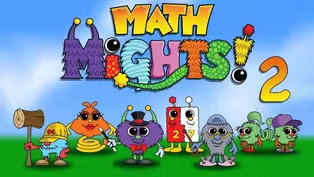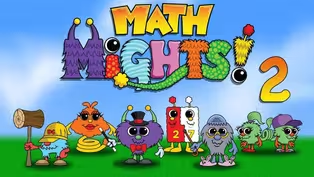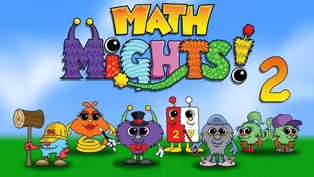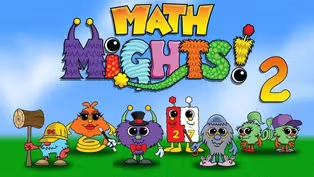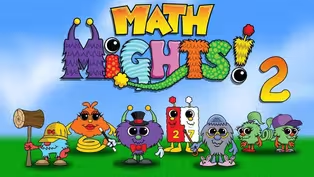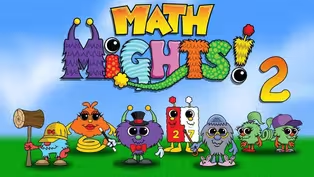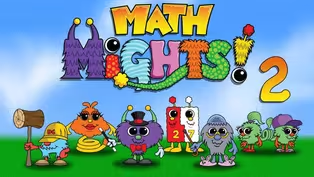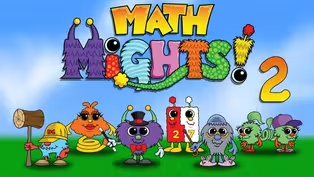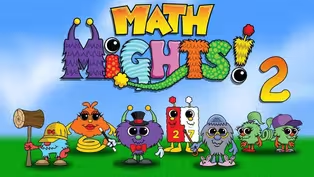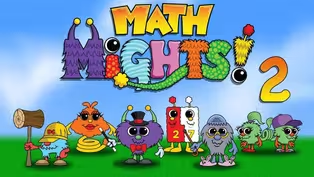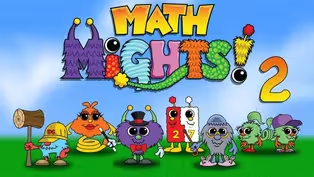Math Mights
Compare 3-Digit Numbers Part 1
Season 3 Episode 304 | 15m 59sVideo has Closed Captions
Join Mrs. McCartney to see if we can figure out Professor Barble's comparison.
Join Mrs. McCartney to go on a mission to see if we can figure out Professor Barble's comparison word problem. Next get ready for some fun with Value Pak and Base-Ten blocks as we compare 3-Digit Numbers
Problems playing video? | Closed Captioning Feedback
Problems playing video? | Closed Captioning Feedback
Math Mights is a local public television program presented by Detroit PBS
Math Mights
Compare 3-Digit Numbers Part 1
Season 3 Episode 304 | 15m 59sVideo has Closed Captions
Join Mrs. McCartney to go on a mission to see if we can figure out Professor Barble's comparison word problem. Next get ready for some fun with Value Pak and Base-Ten blocks as we compare 3-Digit Numbers
Problems playing video? | Closed Captioning Feedback
How to Watch Math Mights
Math Mights is available to stream on pbs.org and the free PBS App, available on iPhone, Apple TV, Android TV, Android smartphones, Amazon Fire TV, Amazon Fire Tablet, Roku, Samsung Smart TV, and Vizio.
Providing Support for PBS.org
Learn Moreabout PBS online sponsorshipMore from This Collection
"Math Mights" lessons for 2nd Grade students.
Video has Closed Captions
Join Mrs. McCartney for some fun with Professor Barble. (15m 59s)
Video has Closed Captions
Join Mrs. McCartney for some fun with Professor Barble. (15m 59s)
Video has Closed Captions
Join Mrs. McCartney for some fun with Professor Barble doing a tricky comparison. (15m 59s)
Video has Closed Captions
Join Mrs. McCartney for a word problem with Professor Barble that will make more sense. (15m 58s)
Video has Closed Captions
Join Mrs. McCartney for a comparison word problem with her friend Professor Barble. (15m 59s)
Compare 3-Digit Numbers Part 2
Video has Closed Captions
Join Mrs. McCartney to learn how to do a comparison word problem with Professor Barble! (15m 59s)
Comparing Numbers on a Number line
Video has Closed Captions
Join Mrs McCartney for a word problem with Professor Barble using Visula Models! (15m 59s)
Numbers represented in different ways
Video has Closed Captions
Representing numbers in different ways to show off your learning with place value. (15m 59s)
Video has Closed Captions
Put numbers together and taking them apart with expanded form. (15m 59s)
Video has Closed Captions
Join Mrs, McCartney for a Number Talk with her friend Springling! (15m 59s)
Video has Closed Captions
Join Mrs, McCartney for a Number Talk with her friend Springling! (16m)
Subtraction with 2-Digit Numbers Part 2
Video has Closed Captions
Join Mrs. McCartney for an addition number talk with D.C.! (16m)
Providing Support for PBS.org
Learn Moreabout PBS online sponsorship(gentle music) (bells chime) (animation boings) (animations screeching) - [Children] Math Mights.
- Welcome back, Math Mights.
Are you ready to have some fun with me doing math?
My name is Mrs. McCartney and I'm so excited that you've joined us today.
Let's check out our plan for today.
Today we're gonna do a word problem with my friend Professor Barble and then we're gonna do some more with comparing three-digit numbers.
We wanna start off by warming up our brain to see if we can conquer a word problem with Professor Barble.
He likes to use visual models.
You might be asking yourself, what is a visual model?
A visual model is used when we do word problems.
It can be used for model drawings, unit bars, tape diagrams, or bar models.
They have lots of different names, but ultimately they are used for a reading comprehension strategy for word problems.
The idea of a visual model is so you can draw a visual model to help you really visualize the strategy and really understand what the word problem is asking.
Instead of guessing, do I add or do I subtract?
We do a visual model that will help you to know which operation to use.
We can't do this without my friend Professor Barble.
Here he comes.
(bright music) Professor Barble is a Math Might that lives in Mathville.
He loves to take tours of Mathville and he encounters lots of word problems.
He wants students to understand that it's not important to get to the answer fast, but instead to slow down.
When he slows down, he can use his thinking cap where a starting line will come out to help you to be able to find the starting point for the word problems.
Today, Professor Barble wants to see if you can play a game with him.
Can you guess what his word problem is that he read somewhere to come up with this picture?
He has a visual model that is above his hat and he wants to know if you can kind of think back to what would have made him even draw that visual model to begin with.
One of our friends says, "I think that we need to subtract to solve this problem."
I like Benita's idea, but it's going right to the operation, and Professor Barble's not going to like that.
He wants us anyways to guess what the word problem is that he read before we get into even solving it.
Let's see what our friend Olivia says.
She said, "Connor has 8 marbles and Emma has 15 marbles.
"How many marbles does Emma and Connor have?"
Hmm, this is a comparison bar, so it's a lot harder than the other word problems that you usually encounter in second grade.
Let's look to see if we agree or disagree with the way Olivia set that problem.
Olivia looked at the visual model that Professor Barble created and she said that Emma had 15 marbles and Connor had 8.
How many do they have altogether?
If that's the case, I wonder what this empty bar is at the top.
Do you think that that could be true, that Connor only has 8?
It's kind of weird if I look at the model drawing because this model shows that it's longer and in fact Emma's is smaller, hmm.
I'm wondering if actually Connor has more and that word problem might need a little bit of help.
Let's see what we think.
So when we look at this we see Connor's marbles and Emma's marbles.
I want you to pay attention to this comparison bar, that maybe the drawing might not be perfect but that these two bars are actually the same.
So Connor has the same amount as Emma, but he actually has 8 more.
So we have to include this amount.
I know that this bar is worth 15, therefore I know that Connor's bar up here is worth 15 and he has an additional 8.
So the problem would read that Connor has 8 more marbles than Emma.
Emma has 15 marbles.
How many do they have altogether?
These are tough problems when you read them, and if you don't use Professor Barble in a visual model, a lot of second graders just guess.
I think we should subtract?
I think that we should add?
We don't wanna do that with word problems.
We wanna have a visual picture of what the problem's asking so there's no question about how to solve it.
I'm looking at this problem and know if they wanna find the total I need to add 15 plus 15 plus 8.
I know if I add 15 plus 15, I can add my 10s first, which is 10, 20, and then add my other 5s which end up being 30.
Then I can add the other 8 to it.
30 plus 8 is easy, it's 38.
So we can see that Emma and Connor have 38 marbles total.
If I were to check it, I know that Emma has 15, Connor has the 15 plus the 8, which equals 38.
Great job doing a really complex problem which is called comparison problems which we'll use a lot in second grade.
Let's check out our I can statement for today.
It says I can use place value to compare three-digit numbers.
Take a look at these base 10 blocks.
Mai has some and Tyler has some.
Who has more?
How do you know?
When you're looking at place value blocks, you have to look at the value of the numbers.
Let's see what our friend Olivia says.
She says, "I think that Mai has more "because she has more blocks."
Let's take a look here to see exactly what our friend Olivia is thinking.
She's looking at the actual blocks, so I'm gonna count how many over here that Mai had.
One, two, three, four, five, six, seven, eight, nine, 10.
Over here, Tyler has one, two, three, four.
Well, if you look at the quantity of the actual blocks, she is correct.
But is that what we know about place value?
Does Mai just have 10 and Tyler only has 4?
No, we have to look at the value.
Who better do we need to call on besides Value Pak?
Hey, Value Pak, come help us out with this problem, we clearly need your help.
(bright music) Value Pak is one of our friends in Mathville and they wear their value on their belly.
When they click together, they show the total amount that that number is, but when they click apart and separate their actual value for that number, whether they're in the hundreds, the tens, or the ones, is displayed on their belly.
I absolutely love using them with second grade students because just the colors and the way they identify really help us to understand place value.
I think that we need to help Olivia to take a look at these two numbers to compare them by looking at the value, not just how many blocks there are.
Let's look a look here so we can go ahead and build the number.
I know that I have 100, which Value Pak can help us see the value of it, and then we have one, two, three, four, five 10s, which equals 50, and then we have four 1s to create the number 154.
Over here we have 200, so here we can represent the value of it.
We have one 10 and then one 1.
By looking at the 100s, we can actually compare these numbers.
So as you can see we took a look at the value of the blocks, not just counting how many blocks there are, so now we can compare our two three-digit numbers.
154 is less, that's why we have it pointed this way, than 211.
Remember, the alligator likes to eat the larger number.
On this side it shows greater, on this side it shows less.
We did a great job looking at comparing those two numbers.
Now let's try another problem.
I want you to take a look at these base 10 blocks.
What is the value of the three-digit number?
And then we're gonna compare.
I want you to take a look at those base 10 blocks and think about which one do you think is greater and which one do you think is less.
Let's first take a look and have Value Pak help us find out the value so we don't just count the blocks.
Let's look at this number here.
We have 100, 200, so I'm gonna go ahead and put the value which is 200.
One, two, three, four, five, six 10s, which has the value of 60.
And then we have one 1.
So we now know that this is 261.
When we look over here we can see that we have 300.
We're gonna put our 300 for the value.
We have one 10, which has the value of 10.
And then we have three 1s.
We now can take a look at this problem of 261 and 313.
Now that you can see that with Value Pak with the base 10 blocks, have you decided which one is greater and which one is less?
I know if I look over here, I can see that this has 300s and this only has 200s, so I know that 313 is greater.
We have the first number written and then the second number, so we have to decide how we're going to put in our greater than our less than sign.
This is less and the alligator wants to eat the larger number.
So if we put this in, that wouldn't be true.
So we're gonna put it in this way to read the full sentence.
261 is less than 313.
We did a great job in that problem 'cause we were able to see how many 100s there were to make it easy to compare.
Let's check out another problem.
Let's compare these two.
Take a look at the base 10 blocks that you see.
I wanna know which one is greater and which one is less.
Let's see what our friend Benita says.
She goes, "That's easy!
"The first one has two 100 blocks so it must be greater."
Do you agree or do you disagree?
That worked for our last problem just fine, but I wonder if it'll work for all the problems.
Let's take a closer look.
Benita said there's two 100s here and only one 100 here, so this must be greater than this.
Let's add this out together and use Value Pak to help us to figure out the value of the numbers first before we see if Benita is correct or incorrect.
When we look here, we have 200, which shows the value here on our place value strip.
We have two 10s, which equals 20, and then we have four 1s which equals 4.
224 is the value for what you see here.
Now when I go over here I see 100.
Oh wow, I see a whole lot of 10s here.
Do you think I should just build that 100 and just let it go?
Or should we slow down a little bit to check to see how many 10s there are?
Let's do that first.
One, two, three, four, five, six, seven, eight, nine, 10, 11, 12.
We know that 10 10s equals 100, so I wanna be able to look at this so we can really figure out the value.
So I'm gonna take my 10 10s and I'm going to exchange it for a 100 so we can see clearly the value of the numbers.
Now I see that we don't just have 100, we actually have 200.
Hey, that's the same as in our first number.
If we look at our 10s, we have two 10s, which is valued at 20, and then we have four 1s.
Oh my goodness, they tricked us.
When you look at both of these, one is not greater and one is not less.
What are they?
224 and 224 means that they're equal.
When Benita was looking at this, I think she just at a glance saw those big 100 blocks and thought it was easy to compare us.
But in second grade we have to be careful and go slow to make sure that if there are more than 10 10s that we regroup and make that into the number that it actually is valued at.
So if we look at 224, we know that it is equal to 224.
When you first look at that, though, it can be tricky.
So be careful that you slow down and look at the value of everything you have before you decide if it is greater than, less than, or equal to.
Now we wanna see if you can compare 338 and 336 with place value discs.
I wanna know how did you know which one was greater.
Now this is a little bit different than the place value blocks which we know is a proportional tool.
This is a non-proportional tool as we look at the discs, so we're looking at the actual value just like Value Pak.
Let's see what our friend Olivia said.
She said, "I had to compare the 1s "because the 100s and the 10s were the same."
Let's take a look.
She said that she had to look at the 100s first but they're the same, so that's not gonna help her figure out which one is greater or less.
She looked at the 10s and they were the same.
So her strategy for this one was to look at the amount of 1s because we see the 300 and the 30, this number here has eight 1s, this one has six 1s, so that makes 338 greater than 336.
There's lots of different ways that we can compare numbers.
We always wanna make sure we're looking very carefully and not just jumping to which one is greater or which one is less.
We'd have to be able to first look at the 100s, then look at the 10s and then look at the 1s and make sure you look at the whole value with the help of Value Pak 'cause that will help you to be able to compare numbers a lot easier.
Now it's your turn to do a comparison activity with Value Pak just like we did today.
I had a fantastic time hanging out with you today.
I sure hope that you learned a lot about comparing numbers.
Check us out right here next time.
(gentle music) (bright music) - [Child] Sis4teachers.org.
- [Child] Changing the way you think about math.
- [Announcer] This program is made possible with funding from the Michigan Department of Education, Governor's Education Emergency Funds, the State of Michigan, and by viewers like you.
(bright music)


- Home and How To

Hit the road in a classic car for a tour through Great Britain with two antiques experts.












Support for PBS provided by:
Math Mights is a local public television program presented by Detroit PBS
